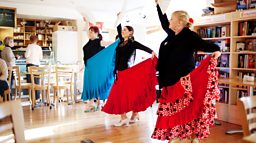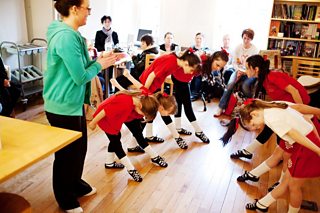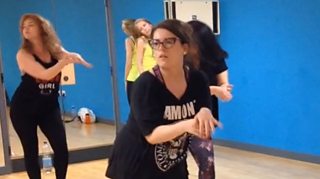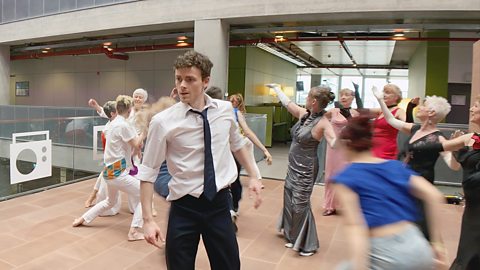Best foot forward
Dance is the UK’s fastest growing art form and one of the most diverse. For some it’s exercise that feels less like hard work than pounding a treadmill. For others, it is the sheer beauty and skill which people appreciate.

Dance is one of the oldest art forms known to man, with a history going back thousands of years. And there are endless ways you can express yourself through dance, whether you are looking to unleash your inner Fonteyn, Flatley or master the Foxtrot. If your feet are getting twitchy already, check out Dance UK, the national voice for dance.
| Why get into dance? | Can it be inexpensive? | Is there a family option? |
|---|---|---|
| It’ll make you feel good about yourself and put a smile on your face. It’s a great way to express yourself, and get fit in the process | Yes! Stick on a CD and dance around your living room. No need to hit the dancefloor for real unless you want to | Watching dance is a great family outing. As for taking a class or even performing together that’s up to you. As Strictly Come Dancing has proved, enthusiasm is more important than talent! Visit Change4Life's Let's Dance section for free online dance routines, games and ideas for all the family |
What would you like to try?
Ballroom

There are endless ways you can express yourself with dance, whether you are looking to unleash your inner Fonteyn or Flatley or master the Foxtrot!
Ballroom dancing found a whole new following when Strictly Come Dancing debuted in 2004, and while some fans just like to watch, others are flocking to classes, eager to glide across the floor in a Waltz or American Smooth, or show off fancy footwork with the fun fast dances like the Charleston and Quickstep. And while it may look elegant, don’t think ballroom is an easy option. It’s a great way to work on core fitness and will certainly get those muscles working.
Latin
If ballroom is about grace and posture, then Latin is the chance to let rip! It too has been back in the spotlight thanks to Strictly, with devotees now able to tell you the difference between a crazy Samba, spicy Salsa and a raunchy Rumba. Latin also encompasses Jive – which in recent years spawned a hugely popular offshoot, Ceroc, the UK’s fastest growing partner dance. And if you are looking for the chance to play diva or toreador, why not try the dramatic Tango or Paso Doble?
Ballet
Say the word ‘dance’ and many people will think of ballet, which has been around for hundreds of years. While other dance styles come and go, classical ballet, which focuses on five main arm and leg positions, never goes out of fashion. Ballet is great for improving your posture, flexibility and for toning and strengthening muscles. Don’t feel you’ve got to be in pointe shoes giving it your best Swan Lake. Contemporary ballet is often performed barefoot with a soundtrack that can be anything from jazz to rock to punk. Check out the work of innovators like Matthew Bourne, Michael Clark and the BalletBoyz, to see how exciting ballet can be.
Contemporary dance
The beauty of contemporary dance is that it is very welcoming and broad in terms of the kind of movement involved. It is usually danced barefoot, and tends to be more weighted and earthbound than ballet, frequently involving movements that take you down to the floor. Although it may seem less formal than ballet, it is just as disciplined. It is constantly evolving and redefining itself, both in the studio and on stage, responding to the world as we find it now. In performance it can involve any style of music (or have none at all), it can be highly technical, with set movements or be improvised, or involve spoken word, film or other multi-disciplinary elements. For inspiration, check out the work of Hofesh Shechter, BalletLorent, Wayne McGregor’s Random Dance, Phoenix Dance Theatre, Richard Alston Dance Company, Candoco Dance Company, and Jasmin Vardimon.
Street dance
Street dance is an art form that came to the fore via music videos, primarily for hip-hop and house. It’s a movement that originated outside the dance studio, in clubs, parks, on the streets and at parties and many new styles are burgeoning. While its history may be in America, the success of British dance groups such as Diversity and Flawless has raised the profile of street dance over here, and this developing genre is a great introduction to dance for those who might have shunned more traditional styles. Just take time to build up your skills before you try spinning on your head!
Traditional dances
The most famous of English traditional folk dances Morris Dancing was first mentioned in print in the 1400s. Seen as a celebration of the traditions of a community, Highland Dancing and Country Dance continue to be popular in Scotland, while the intricate footwork associated with Irish Dancing found a new audience thanks to the phenomenon of Riverdance. Suitable for dancers of all ages, traditional dance can be a great way of keeping history alive – and having a lot of fun! Also look out for celidhs or classes in line dancing which you can start without any training at all.
Tap dance
Today tap dancing is as big as it was in the heyday of Fred Astaire and Gene Kelly, thanks to the popularity of shows like Tap Dogs, a non-stop 80 minute dance show from Australia, that’s still touring the world after nearly two decades. As a dance form tap evolved in America drawing on elements of African dance, Irish dance and clog dancing. All you need to have a go is a pair of shoes, and a desire to get tapping.
Bollywood
Bollywood Dance is traditionally based on Indian Classical dance styles such as Kathak and Bharatnatyam - which inspire the delicate hand gestures and graceful angular movements - but has been fused with many other Indian and world styles (including Bhangra, Hip Hop, Contemporary and Salsa). All merge to become a fun and energetic style which can be enjoyed by all! It keeps your body moving throughout and teaches you to distribute that energy throughout your body - from your core, right to your fingertips.
Historian and curator Lucy Worsley and the thrill of dancing

"Creativity means getting out of yourself and forgetting about normal life"
Getting into the groove
Jasmin Shorter, London: I work for a firm of stockbrokers, as a Professional Development Manager. I keep an eye on the financial markets away from work, but I have always found it important to have a creative outlet.

At my first lesson I was spinning the wrong way, getting my left and right muddled, then my glasses went flying across the room
I go to dance classes where we learn the choreography from music videos. My musical taste isn’t highbrow - Madonna, Beyonce, Kylie Minogue – and I couldn’t believe it when I found this class existed.
At my first lesson I was spinning the wrong way, getting my left and right muddled, then my glasses went flying across the room! But everyone is really supportive, and it’s about building self-esteem as much as anything.
Now I dance for about seven hours a week. I’d always skive off PE at school, but this doesn’t feel like exercise. I used to be quite significantly heavier than I am, and a few years ago decided to lose weight for health reasons. But dieting and the gym felt like a chore.
This has been such a positive experience - now I want to eat more healthily to have the energy to do what I want to do. And it’s great for stress relief. I might have had a tough day at work or have things going on in my personal life, but I spend an hour dancing and come out feeling so free.
I can be quite controlled in normal life and it was quite a big thing for me, learning how to let go. Normally I’m checking my phone all the time, but in a dance class you can’t, and don’t care. You are just completely there, in the moment.
Flight

Flight | 43 dancers. One staircase. One smartphone. One take
An extraordinary dance performance in BBC Scotland’s Pacific Quay building.
